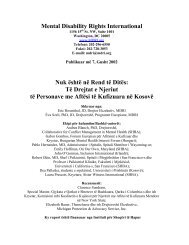Torture not Treatment - Disability Rights International
Torture not Treatment - Disability Rights International
Torture not Treatment - Disability Rights International
You also want an ePaper? Increase the reach of your titles
YUMPU automatically turns print PDFs into web optimized ePapers that Google loves.
TORTURE NOT TREATMENT<br />
‗bad‘ or ‗sick‘ and needs to be locked up. The experience may be particularly problematic for<br />
children who have been victims of violence or abuse.‖ 141<br />
The state of Massachusetts, in its own regulations governing the use of Level III aversives at<br />
JRC, which include electric shock and restraint, describe the punishments as any that ―pose a<br />
significant risk of physical or psychological harm to the individual.‖ 142<br />
Pain is inflicted intentionally<br />
The definition of torture under the UN Convention against <strong>Torture</strong> requires that pain or suffering<br />
be inflicted intentionally. When the United States ratified the UN Convention against <strong>Torture</strong>, it<br />
adopted an explicit understanding that ―in order to constitute torture, an act must be specifically<br />
intended to inflict severe physical or mental suffering.‖ 143 Negligent conduct alone can<strong>not</strong> rise to<br />
the level of torture, though it may constitute inhuman and degrading treatment also prohibited by<br />
the UN Convention against <strong>Torture</strong>. 144<br />
A practice might <strong>not</strong> constitute torture in the narrowest sense of the term if it is an ―unintended<br />
side-effect‖ of the treatment. 145 The practices of electric shock and long-term restraints at JRC,<br />
however, fit within the definition because they are inflicted systematically and specifically to<br />
induce pain and inflict punishment. Pain is <strong>not</strong> the incidental side-effect of the practices<br />
perpetrated against children or adults at JRC – it is exactly what is intended.<br />
The UN Special Rapporteur on <strong>Torture</strong>, Manfred Nowak, has made clear that the stated intent of<br />
a health care professional to cure a person of his or her illness or disability is no defense of a<br />
practice that meets the other elements of torture. ―This is particularly relevant in the context of<br />
medical treatment of persons with disabilities,‖ says Nowak, ―where serious violations and<br />
discrimination against persons with disabilities may be masked as ‗good intentions‘ on the part<br />
of health professionals.‖ 146<br />
Pain is inflicted for a prohibited purpose<br />
For a practice to constitute torture, it must have a purpose prohibited by article 1(1) of the<br />
Convention against <strong>Torture</strong>. Nowak has described the purpose requirement as ―the most decisive<br />
criterion which distinguishes torture from cruel or inhuman treatment.‖ The requirement of a<br />
prohibited purpose is probably the main reason why abuses in a medical context are <strong>not</strong> usually<br />
thought of as torture – since the stated purpose is to ameliorate a condition or illness. At JRC,<br />
clearly the intentional infliction of severe pain is for the purpose of coercing individuals to end<br />
behaviors deemed by JRC medical authorities to be improper.<br />
It is important to <strong>not</strong>e that under international law, a prohibited purpose need <strong>not</strong> be an improper<br />
purpose. <strong>Torture</strong> is prohibited for law enforcement authorities seeking to investigate violations<br />
of criminal law or security officials investigating terrorism – whether or <strong>not</strong> the torture is<br />
25




